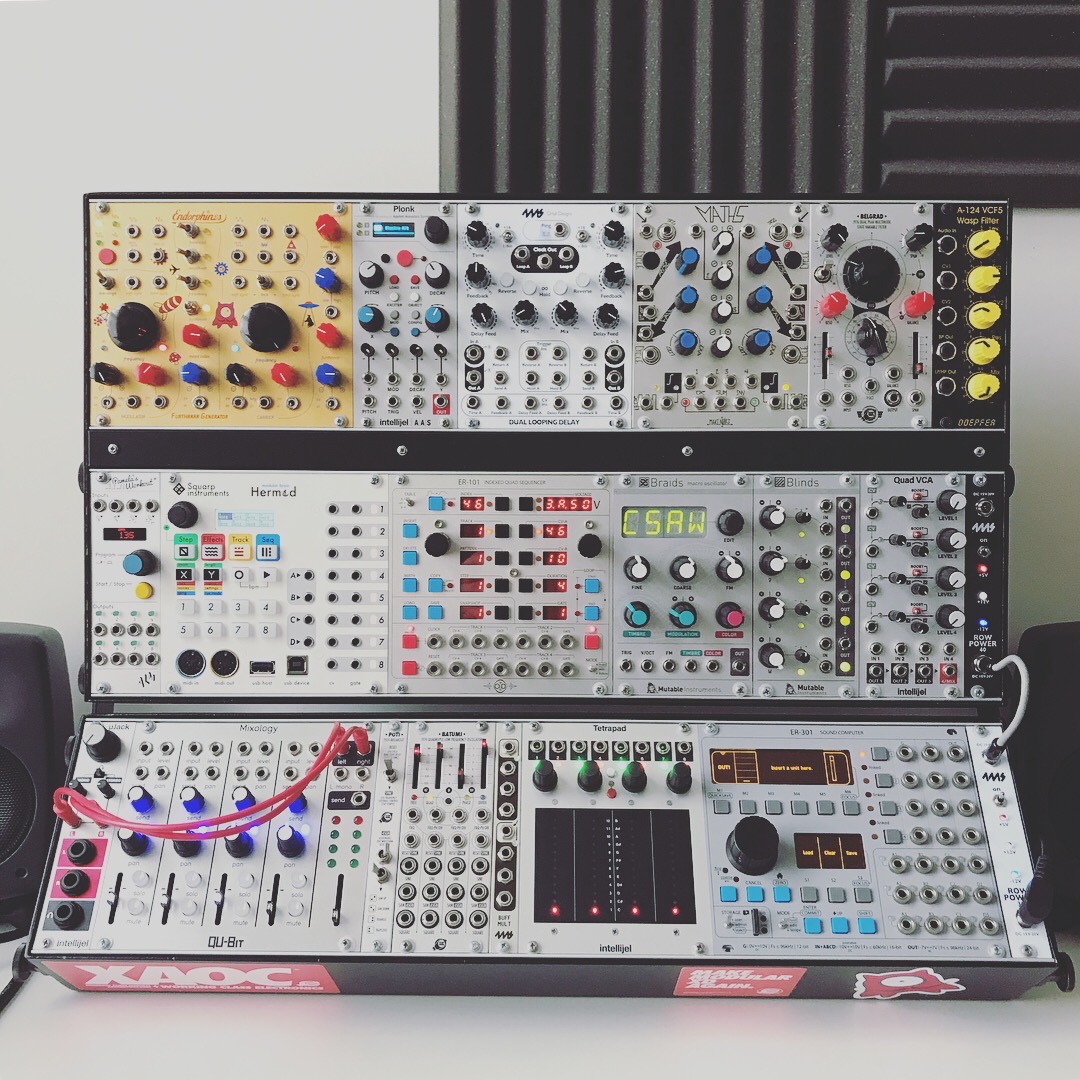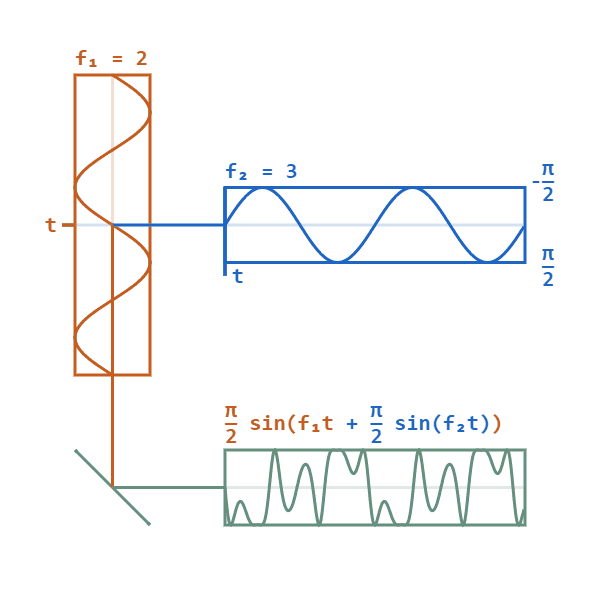|
Arturia MicroFreak
The MicroFreak is a synthesizer manufactured by French music technology company Arturia and released in 2019. Described as a "Hybrid Experimental Synthesizer", it uses 18 digital sound engines (algorithms) to synthesize raw tones. This digital oscillator is then fed into a multi-mode analog filter, giving the MicroFreak its hybrid sounds. Sound engines The MicroFreak has 22 distinct sound engines (as of the 5.0 update), which are: *Basic Waves – a standard synth voice using traditional waveforms *Super Wave – a group of detuned waves (like a supersaw), *Harmonic – a form of additive synthesis where you set volumes of frequencies individually, * Karplus-Strong – a physical modelling system to replicate string sounds, * Wavetable – a method of synthesis where the waveform transitions through a table of different waveforms, * Noise – various types of noise and static. * Virtual Analogue – a standard subtractive synth voice, *Waveshaper – a triangle wave that is ... [...More Info...] [...Related Items...] OR: [Wikipedia] [Google] [Baidu] |
NAMM Show
The NAMM Show is an annual event in the United States that is organized by the National Association of Music Merchants (NAMM), who describe it as "the industry’s largest stage, uniting the global music, sound and entertainment technology communities". Overview The NAMM Show takes place annually in Anaheim, California, at the Anaheim Convention Center, and is one of the largest music product trade shows in the world. Its European counterpart is the ''Musikmesse'' in Frankfurt. The event attracts numerous famous musicians, many of whom are endorsed by exhibitors and come to promote their own signature models and equipment. NAMM is a trade-only business show catering to domestic and international dealers and distributors. The product exhibits are an integral part of the show, allowing the dealers and distributors to see what's new, negotiate deals and plan their purchasing for the next 6 to 12 months. Exhibitors are allotted a specific number of attendees based on the size of th ... [...More Info...] [...Related Items...] OR: [Wikipedia] [Google] [Baidu] |
Waveshaper
In electronic music, waveshaping is a type of distortion synthesis in which complex spectra are produced from simple tones by altering the shape of the waveforms. Uses Waveshapers are used mainly by electronic musicians to achieve an extra-abrasive sound. This effect is most used to enhance the sound of a music synthesizer by altering the waveform or vowel. Rock musicians may also use a waveshaper for heavy distortion of a guitar or bass. Some synthesizers or virtual software instruments have built-in waveshapers. The effect can make instruments sound noisy or overdriven. In digital modeling of analog audio equipment such as tube amplifiers, waveshaping is used to introduce a static, or memoryless, nonlinearity to approximate the transfer characteristic of a vacuum tube or diode limiter. How it works A waveshaper is an audio effect that changes an audio signal by mapping an input signal to the output signal by applying a fixed or variable mathematical function, calle ... [...More Info...] [...Related Items...] OR: [Wikipedia] [Google] [Baidu] |
Synthesizers Top Down
A synthesizer (also spelled synthesiser) is an electronic musical instrument that generates audio signals. Synthesizers typically create sounds by generating waveforms through methods including subtractive synthesis, additive synthesis and frequency modulation synthesis. These sounds may be altered by components such as filters, which cut or boost frequencies; envelopes, which control articulation, or how notes begin and end; and low-frequency oscillators, which modulate parameters such as pitch, volume, or filter characteristics affecting timbre. Synthesizers are typically played with keyboards or controlled by sequencers, software or other instruments, and may be synchronized to other equipment via MIDI. Synthesizer-like instruments emerged in the United States in the mid-20th century with instruments such as the RCA Mark II, which was controlled with punch cards and used hundreds of vacuum tubes. The Moog synthesizer, developed by Robert Moog and first sold in ... [...More Info...] [...Related Items...] OR: [Wikipedia] [Google] [Baidu] |
Eurorack
Eurorack is a modular synthesizer format originally specified in 1995 by Doepfer Musikelektronik. It has since grown in popularity, and as of 2022 has become a dominant hardware modular synthesizer format, with over 15,000 modules available from more than 1000 different manufacturers ranging from DIY kits and boutique, cottage-industry designers to well-known, established synth mass-manufacturers like Moog and Roland. Compact size, 3.5mm mono jacks and cables for patching all signals, and lack of a visual or sonic aesthetic defined by one manufacturer sets Eurorack apart from other modular synthesizer formats, and these factors have contributed to the popularity of Eurorack among both manufacturers and musicians. History Before Eurorack, in the late 1970s, several modular systems based on the industrial “Euro” card frames appeared: * Elektor Formant (3U or 6U x 7HP, 3.5 mm jacks, 31 pin bus, +/-15V) * BME PM10/Axiom (3U x 8HP, RCA/Phono jacks, 31 pin bus, +/-15V) * ... [...More Info...] [...Related Items...] OR: [Wikipedia] [Google] [Baidu] |
Voice Changer
The term voice changer (also known as voice enhancer) refers to a device which can change the tone or pitch of or add distortion to the user's voice, or a combination and vary greatly in price and sophistication. A kazoo/didgeridoo can be used as a makeshift voice changer, though it can be difficult to understand what the person is trying to say. Hardware implementations The earliest voice changers were electronic devices usually used over the telephone for the purpose of disguise. There are low-priced, small lithium battery-powered voice changers that are used between a phone's mouthpiece and the user's mouth. More sophisticated voice changers have different levels of various distortion effects variable by faders. Software implementations Nowadays, software implementations are very common. There is a plethora of techniques that modify the voice by using different algorithms. Most algorithms modify the voice by changing the amplitude, pitch and tone of the voice. The pitch play ... [...More Info...] [...Related Items...] OR: [Wikipedia] [Google] [Baidu] |
Vocoder
A vocoder (, a portmanteau of ''voice'' and ''encoder'') is a category of speech coding that analyzes and synthesizes the human voice signal for audio data compression, multiplexing, voice encryption or voice transformation. The vocoder was invented in 1938 by Homer Dudley at Bell Labs as a means of synthesizing human speech. This work was developed into the channel vocoder which was used as a voice codec for telecommunications for speech coding to conserve bandwidth in transmission. By encrypting the control signals, voice transmission can be secured against interception. Its primary use in this fashion is for secure radio communication. The advantage of this method of encryption is that none of the original signal is sent, only envelopes of the bandpass filters. The receiving unit needs to be set up in the same filter configuration to re-synthesize a version of the original signal spectrum. The vocoder has also been used extensively as an electronic musical instrument. ... [...More Info...] [...Related Items...] OR: [Wikipedia] [Google] [Baidu] |
Phase Modulation
Phase modulation (PM) is a modulation pattern for conditioning communication signals for transmission. It encodes a message signal as variations in the instantaneous phase of a carrier wave. Phase modulation is one of the two principal forms of angle modulation, together with frequency modulation. In phase modulation, the instantaneous amplitude of the baseband signal modifies the phase of the carrier signal keeping its amplitude and frequency constant. The phase of a carrier signal is modulated to follow the changing signal level (amplitude) of the message signal. The peak amplitude and the frequency of the carrier signal are maintained constant, but as the amplitude of the message signal changes, the phase of the carrier changes correspondingly. Phase modulation is widely used for transmitting radio waves and is an integral part of many digital transmission coding schemes that underlie a wide range of technologies like Wi-Fi, GSM and satellite television. It is also used fo ... [...More Info...] [...Related Items...] OR: [Wikipedia] [Google] [Baidu] |
Bassline
Bassline (also known as a bass line or bass part) is the term used in many styles of music, such as blues, jazz, funk, Dub music, dub and electronic music, electronic, traditional music, traditional, or classical music for the low-pitched Part (music), instrumental part or line played (in jazz and some forms of popular music) by a rhythm section instrument such as the bass guitar, electric bass, double bass, cello, tuba or keyboard (piano, Hammond organ, electric organ, or synthesizer). In unaccompanied solo performance, basslines may simply be played in the lower register (music), register of any instrument while melody and/or further accompaniment is provided in the middle or upper register. In solo music for piano and pipe organ, these instruments have an excellent lower register that can be used to play a deep bassline. On organs, the bass line is typically played using the pedal keyboard and massive 16' and 32' bass pipes. Riffs and grooves Basslines in Pop music, popular m ... [...More Info...] [...Related Items...] OR: [Wikipedia] [Google] [Baidu] |
Voice Synthesizer
Speech synthesis is the artificial production of human speech. A computer system used for this purpose is called a speech synthesizer, and can be implemented in software or Computer hardware, hardware products. A text-to-speech (TTS) system converts normal language text into speech; other systems render symbolic linguistic representations like phonetic transcriptions into speech. The reverse process is speech recognition. Synthesized speech can be created by Concatenative synthesis, concatenating pieces of recorded speech that are stored in a database. Systems differ in the size of the stored speech units; a system that stores phone (phonetics), phones or diphones provides the largest output range, but may lack clarity. For specific usage domains, the storage of entire words or sentences allows for high-quality output. Alternatively, a synthesizer can incorporate a model of the vocal tract and other human voice characteristics to create a completely "synthetic" voice output. The ... [...More Info...] [...Related Items...] OR: [Wikipedia] [Google] [Baidu] |
Paraphony
Paraphony is a term which has three distinct meanings in the field of music. In musical theory Paraphony is a term used in musical vernacular to refer to consonances which rely upon intervals of fifths and fourths. This terminology can be traced to ancient Greece and sources such as Theon of Smyrna. In electronic music Completely unrelated to the above sense, a synthesizer is called paraphonic if it can play multiple pitches at once, but those pitches share part of their electronic signal paths. For example, the Roland RS-202 string machine could play several dozen pitches at once, but only with a single shared volume envelope, requiring the collective chord to swell and diminish as a single cohesive whole. Similarly, the Korg Poly-800 had 8 oscillators and could produce 8 voices, but had just one filter circuit shared by all of them. Other examples include the Roland VP-330 vocoder and the Moog Sub 37. Demonstration Non-paraphonic polyphony The following example ... [...More Info...] [...Related Items...] OR: [Wikipedia] [Google] [Baidu] |
Chords In Music
A chord, in music, is any harmonic set of pitches/frequencies consisting of multiple notes (also called "pitches") that are heard as if sounding simultaneously. For many practical and theoretical purposes, arpeggios and broken chords (in which the notes of the chord are sounded one after the other, rather than simultaneously), or sequences of chord tones, may also be considered as chords in the right musical context. In tonal Western classical music (music with a tonic key or "home key"), the most frequently encountered chords are triads, so called because they consist of three distinct notes: the root note, and intervals of a third and a fifth above the root note. Chords with more than three notes include added tone chords, extended chords and tone clusters, which are used in contemporary classical music, jazz and almost any other genre. A series of chords is called a chord progression. One example of a widely used chord progression in Western traditional music and blues ... [...More Info...] [...Related Items...] OR: [Wikipedia] [Google] [Baidu] |





